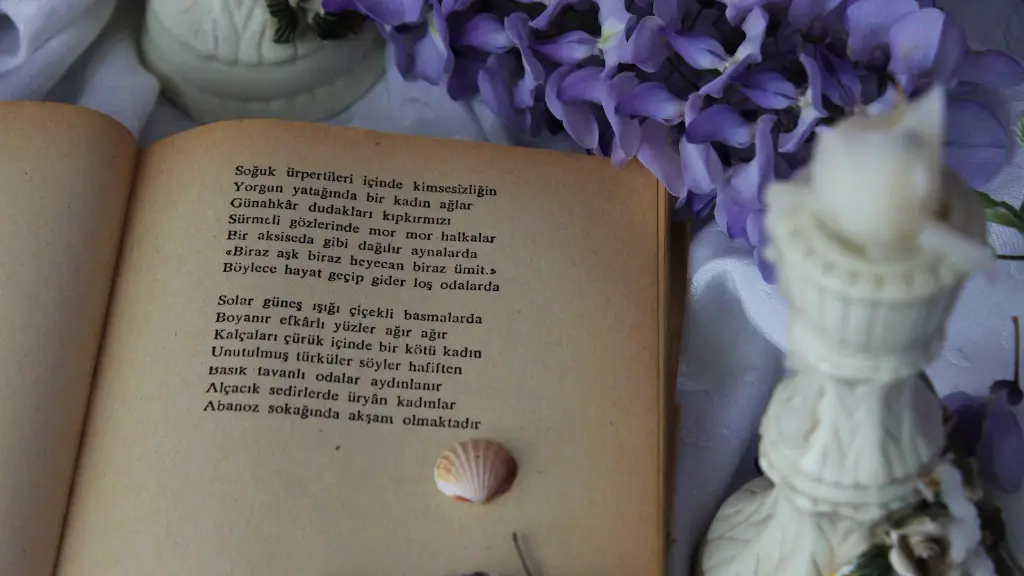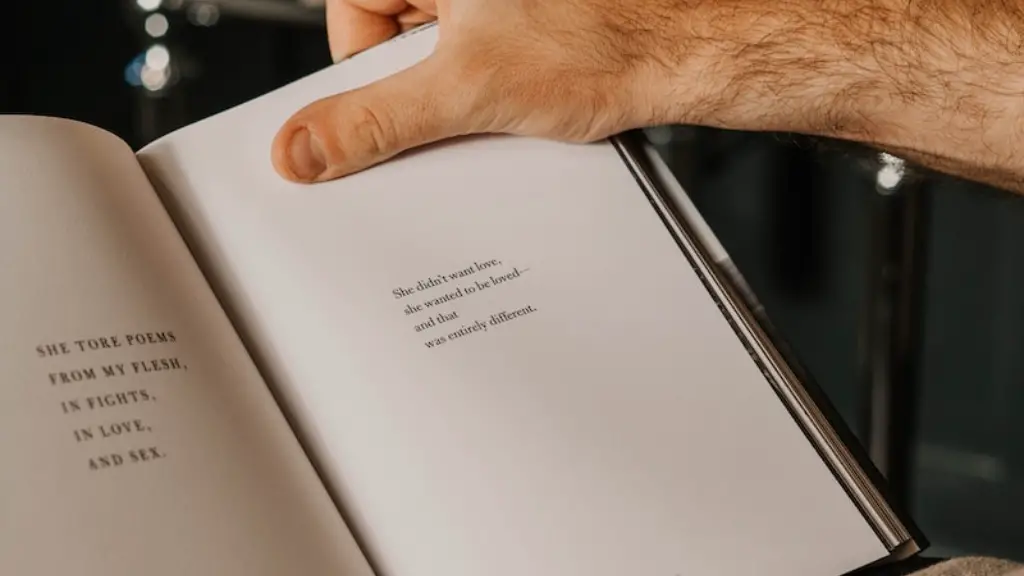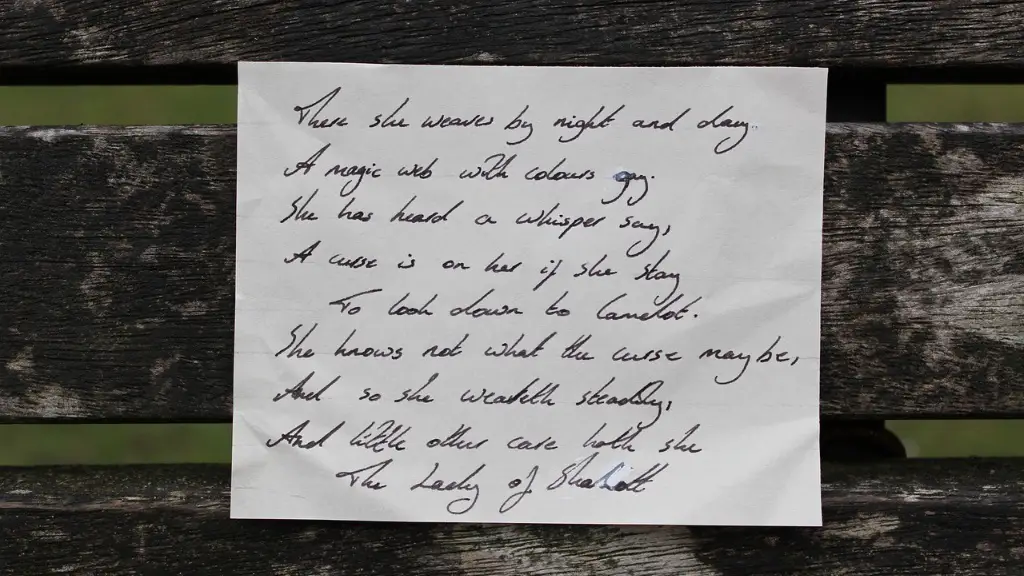The beauty of poetry lies in its ability to evoke emotion and effects with words. The use of rhyme plays a big role in this, as it has a way of leading the reader along and providing an aesthetically pleasing end result. Rhyme, when used correctly, can create a sense of flow and momentum throughout the poem, enabling readers to gain deeper insights into its meaning as they peruse it. But why is rhyme so important in poetry? Let’s dive deeper into its role and how it can affect the emotions of readers.
Rhyme adds a sense of cohesiveness to a poem. It provides the building blocks for a rhythm and helps create a overall flow to the piece. This can give the poem a certain cadence or tempo that the reader can identify and follow, allowing the poet to establish their own unique style. It can also help to give voice to the poem, as the words and ideas require certain syllables to dovetail into each other correctly. Rhyme also serves to give the poem a certain visual quality, as the words often appear aligned in an aesthetically pleasing fashion.
Experts have also argued that rhyme is important for maintaining a memorable quality in the poem. Knowing that certain words will end in the same sound allows readers to associate the words, thus forming a mental link between them. This can aid them in understanding the overall poem in more depth and making more emotional connections throughout. It is sharper and creates a deeper emotional impact on the reader. In this way, rhyme can draw attention to certain words or phrases in the poem, allowing the reader to better grasp their significance and meaning.
Moreover, when a poem utilizes a certain type of rhyme, such as an ABAB pattern or a couplet, this can give a timeless quality to the poem. This allows readers to digest the poem with deeper understanding and appreciation. Rhyme can also be used to signal the end of a stanza or create a memorable mood or atmosphere in the poem.
Finally, without rhyme, the poem would often sound disjointed and choppy. There may be plenty of lyricism and beauty in the words, but without rhyme they lose their impact. It is not only the sound of the words that creates a lasting impression, but also the way in which they are arranged. Rhyme adds another layer of emotion that can help to bring the poem to life and give words power and strength.
Rhyme and its Relationship to Metaphor
In addition to its role in establishing rhythm and flow, rhyme often plays an important role in linking metaphors and similes in poems. With rhyme, it is easier for the poet to weave their metaphors together in such a way that readers can gain greater insight into their meaning. Rhyme can be used to enhance the metaphor, highlighting certain ideas and drawing the reader into a deeper understanding and appreciation of the poem.
Rhyme can also help to bring out the full vitality of metaphors, as it provides the perfect sound to accompany the visuals. This can give the poem more drama, making it more engaging and enjoyable to read. Rhyme also adds to the overall development of the poem, as it allows the reader to fill in any gaps between metaphors and gain a greater understanding of the poem’s underlying meaning.
Aesthetic Quality in Poetry
The final reason why rhymes is so important in poetry is that it helps to create a pleasant aesthetic quality in the poem. This is achieved by the words and phrases that rhyme conveniently overlapping and creating a pleasing pattern. It can give the poem a certain color and texture, allowing the reader to appreciate it more fully.
This also allows the poet to create a unique style for their poem, as different words and phrases can be used to provide a certain sound. Additionally, this can be used to signify the different emotions and feelings in the poem, providing a greater degree of depth and understanding to the piece.
Rhyme and Refrain
Rhyme can also be used to signal a change in the poem or a shift in mood. This can be done through the intentional use of a refrain, which is a recurring phrase or line in a poem used to signal this change. It can add to the drama of the poem and create suspense and anticipation, keeping the reader engaged throughout.
In addition, a refrain can often be used to make the poem feel focused and unified, creating a quick and easy way for the reader to identify with the poet’s thoughts and ideas. This can make the poem more accessible and interesting to read, thus increasing its impact and helping to establish an emotional connection between the reader and the poet.
Rhyme and Symbolism
Rhyme is also often used to add a certain degree of symbolism to the poem. Rhyming words can often be used to indicate certain symbols or allusions in the poem, allowing for even deeper interpretations. This can help the reader to gain a wider understanding of the poet’s underlying themes and ideas, providing a further layer of meaning to the poem.
Furthermore, rhyme can also be used to indicate a certain emphasis on certain words or lines. This can give the poem more focus and make the words feel important without the need to be explicit. Rhyme can also be used to form allegories or metaphors, enriching the overall impact of the poem.
Rhyme and Its Emotional Impact
Finally, rhyme is important in poetry because of its effect on the emotions of the reader. Meticulously placed rhymes can help to give a rhythm to the poem, creating a steady cadence that the reader can follow and thus leading them through the poem. This can help to build a certain atmosphere in the poem and can lead the reader to feel certain emotions at certain points.
Knowing that a certain word or phrase will end in a certain sound can also allow for greater anticipation, thus providing a unique and heightened emotional experience for the reader. Rhyme can thus serve as an emotional arrow, pointing the reader in the right direction and ultimately leading to a greater appreciation of the poem.
Rhyme and its Role in Literature
Overall, rhyme is an integral and powerful tool when it comes to poetry. It enables the poet to express their thoughts and feelings in a more creative and vivid manner, allowing readers to become more deeply invested in the poem. Rhyme can be used to create a certain tempo and energy in the poem, providing the perfect anchor for words and ideas to attach themselves to. When used properly, rhyme can add a certain beauty and elegance to a poem, solidifying its place in Literature.
Rhyme and its Value as a Poetic Device
Rhyme can also be used to add value to certain phrases and words in a poem, as it allows the reader to draw attention to them and remember them more easily. This can be used to lend emphasis to certain ideas, thus emphasizing the overall message of the poem. Additionally, it is much easier to remember a poem when it utilizes rhyme, as the flow of the words is more memorable and accessible.
It is perhaps this quality that is one of the main draws of rhyme: it provides a way for the reader to connect with the poem more viscerally and emotionally. Through its use of repetition, rhyme can help to create an experience that touches the reader in a unique and meaningful way.
Rhyme and its Essential Nature in Poetry
In conclusion, rhyme is essential to poetry, as it provides a way for the poet to express emotion, convey meaning, and create a certain flow and rhythm to their piece. Through its intentional placement, rhyme can also be used to evoke certain feelings in the reader, as well as provide an aesthetically pleasing pattern for the poem. Rhyme is also used to create a unique atmosphere in the poem, making it more memorable and engaging for the reader. As such, it is an invaluable tool for the poet and one that should not be underestimated.




